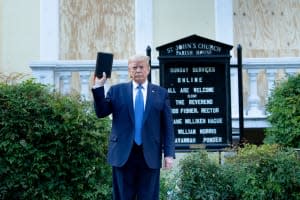Police didn't clear protesters from Lafayette Park for Trump photo op, IG report says

Police didn't clear protesters out of Lafayette Park in June 2020 so that former President Donald Trump could stage a photo op, according to a new inspector general report.
The Interior Department inspector general came to this conclusion in a report released Wednesday, which examined the circumstances under which U.S. Park Police controversially dispersed protesters in Washington, D.C. prior to Trump walking to St. John's Church for a photo-op on June 1, 2020, per NBC News.
"The evidence we obtained did not support a finding that the [U.S. Park Police] cleared the park to allow the president to survey the damage and walk to St. John's Church," the report says.
Rather, the report says that police cleared the area so that a contractor could install antiscale fencing "in response to destruction of property and injury to officers occurring" in the previous days. The USPP wasn't aware of Trump's movement until "mid-to-late" afternoon that day, after it had already started to develop its operational plan, according to the report.
However, the inspector general found that Attorney General William Barr urged officials to speed up the clearing of the area once Trump had set his plans to walk through, according to NBC News. Barr, the IG found, asked the USPP operations commander, "Are these people still going to be here when POTUS comes out?" The commander reportedly responded, "Are you freaking kidding me?"
The report additionally concluded that while the USPP issued dispersal warnings to the crowd using a long-range acoustic device, "not everyone could hear the warnings," and the USPP's lack of a "detailed dispersal warning policy" may have "led to the ineffective warnings issued to the crowd." The IG also cited "weaknesses in communication and coordination," which "may have contributed to confusion during the operation and the use of tactics that appeared inconsistent with the incident commander's operational plan."
